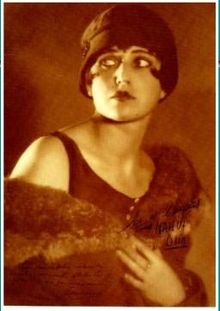- Carmen Mondragón
-
"Nahui Olin" Born María del Carmen Mondragón Valseca
July 8, 1893
Tacubaya, today Mexico CityDied January 23, 1978 (aged 84)
Mexico CityHair color dark brown varying to blonde Eye color green Spouse Manuel Rodríguez Lozano Relatives Gerald Murillo,
Matías Santoyo,
Antonio Garduño,
Eugenio AgacinoMaría del Carmen Mondragón Valseca, also known as "Nahui Olin" (b. Tacubaya, today Mexico City, July 8, 1893 – d. Mexico City, January 23, 1978) was a Mexican artist's model, painter and poet.
Contents
Biography
Carmen Mondragón was the fifth of eight children of General Manuel Mondragón, Secretario de Guerra y Marina in 1913. Her mother was Mercedes Valseca. Carmen Mondragón received a privileged education in Mexico, and afterwards from 1897 to 1905 in France. The professional activities of General Mondragón, who specialized in artillery design, led the family to Spain in 1905, where she met cadet Manuel Rodríguez Lozano, whom she married on August 6, 1913. Although General Mondragón went into exile to Belgium after the occurrences of the Decena Trágica, Carmen Mondragón moved to Paris with her husband,[1] where they met Pablo Picasso, Henri Matisse and Jean Cassou. Afterwards they moved to San Sebastián, Spain, where Carmen's brother Manuel ran a photo studio. In San Sebastián, both started painting.
In 1921 both returned to Mexico, where they went separate ways. Whether they were ever divorced is unknown. Carmen Mondragón turned towards the artists' scene of Mexico City, got contacts with José Vasconcelos and Xavier Villaurrutia, and was interested in the Teatro Ulises movement. She had multiple sexual affairs. Her beauty is described as mesmerizing and erotic, and she was apparently the first woman in Catholic Mexico who wore a miniskirt. She became model of several notable painters and photographers, among others posing for some of Diego Rivera's murals, for Tina Modotti, Antonio Garduño, Roberto Montenegro, Matías Santoyo, Edward Weston and in 1928 for Ignácio Rosas at the Escuela Nacional de Bellas Artes.[2] Especially her nudes became famous. When a former French teacher of her recognized her pictures, he published A dix ans sur mon pupitre (From my desk, at 10 years old), a book of 1924, which describes the 10 year old pupil Carmen Mondragón within his teacher's sight. Carmen Mondragón had an intense love relationship with Gerald Murillo, also known as Dr Atl, who named her "Nahui Olin", a symbol of Aztec renewal meaning "four movement", the symbol of earthquakes. They lived together in the former La Merced Cloister. At this time she wrote her poems Óptica cerebral, poemas dinámicos (1922) and Calinement je suis dedans (1923), finished several naïve paintings, and composed. As intensely as the love relationship began, it ended equally quickly in the mid 1920s. Later she denied it completely. After having several further affairs, she stepped out of public life in the 1940s.
As in Frida Kahlo's life, interest in her life increased after her death. Carmen Mondragón is considered one of the talented and revolutionary women who formed the 1920s and 1930s in Mexico by activism and creativity, like Guadalupe Marín, Antonieta Rivas Mercado, Frida Kahlo, Tina Modotti, Lupe Vélez and María Izquierdo. Her popularity was due more to her beauty than to her artistic and literary work. She herself described her work as intuitive. All her self-portraits show oversized, green eyes, but her eyes seem highlighted also in paintings by other artists. Many of her works are undated.[3][4][5][6][7]
Her works were exhibited in the National Museum of Mexican Art in Chicago in 2007, in an exhibition titled A Woman Beyond Time/Nahui Olin: una mujer fuera del tiempo.
Literature
- Adriana Malvido: Nahui Olin, la mujer del sol, ISBN 8477652066, ISBN 978-8477652069
- Pino Cacucci: Nahui, 2005, ISBN 8807016869
- Dr. Atl: Gentes Profanas En El Convento, ISBN 9707270349, ISBN 9789707270343
External links
- Carmen Mondragón in the Ibero-American Institute (Prussian Cultural Heritage Foundation) catalogue, Berlin
- Photos and paintings of Nahui Olin
References
- ^ Las hijas del porfiriato (Spanish), July 25, 2007.
- ^ Primera exposición para descubrir el valor de la obra de Agustín Jiménez (second photo from top) in LaJornada, October 25, 2007.
- ^ Hernando Hernández Pérez: Nahui Olin (I) (Spanish), September 13, 2007.
- ^ Hernando Hernández Pérez: Nahui Olin (II) (Spanish), September 14, 2007.
- ^ Erin Cassin: The Fiery Spirit of Carmen Mondragón, 2005.
- ^ Enrique López Aguilar: Así te fuiste, Nahui, tan collando… (Spanish), LaJornada, UNAM.
- ^ also used: Carmen Mondragón in the Spanish Wikipedia; version from August 19, 2008, 00.17
Categories:- Mexican painters
- Mexican poets
- Mexican women artists
- Mexican women writers
- Mexican artists' models
- People from Mexico City
- 1893 births
- 1978 deaths
Wikimedia Foundation. 2010.

